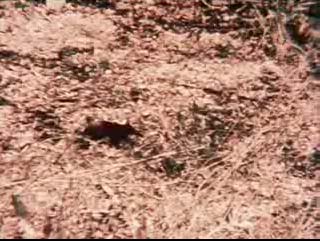 |
Walking
Golden-rumped Sengi
Rhynchocyon chrysopygus
Gedi Ruins, Watamu, Kenya, ca. 1971.
The four giant sengis (genus Rhynchocyon) neither climb nor burrow, but spend their time on the forest floor. At night, they retreat to a leaf nest on the forest floor.
|
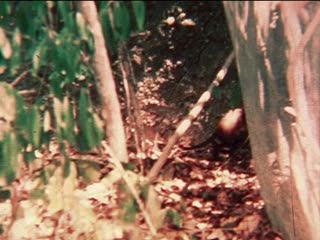 |
Foraging Leaf Litter
Golden-rumped Sengi
Rhynchocyon chrysopygus
Gedi Ruins, Watamu, Kenya, ca. 1971.
Giant sengis (genus Rhynchocyon) are dependent on dense leaf litter, where they find small invertebrates, which they flick up with their very long tongue.
|
 |
Feeding millipede
Golden-rumped Sengi
Rhynchocyon chrysopygus
Gedi Ruins, Watamu, Kenya, ca. 1971.
Large prey, including millipedes, are awkwardly torn into pieces before being ingested, often ant-eater style with a flick of the tongue.
|
 |
Cursorial Flight
Golden-rumped Sengi
Rhynchocyon chrysopygus
Gedi Ruins, Watamu, Kenya, ca. 1971.
Giant sengis (genus Rhynchocyon) might be thought of as a combination of a small ant-eater (nose), a small antelope (long and thin legs), and a rodent (tail). Like antelopes, they can run very fast across the forest floor.
|
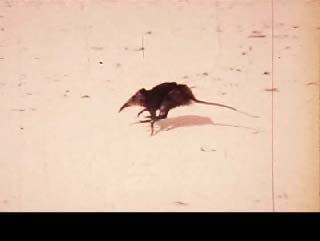 |
Tethered locomotion
Golden-rumped Sengi
Rhynchocyon chrysopygus
Watamu Beach, Kenya, ca. 1971.
Old accounts erroneously indicate that sengis run by hopping, like small kangaroos. In fact, they run using a half-bound gait, as demonstrated by this ultra-slow-motion sequence of a tethered animal.
|
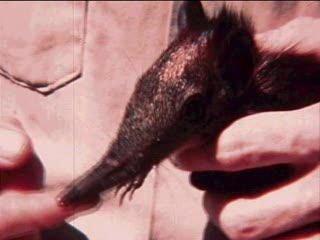 |
In-hand
Rynchocyon
Golden-rumped Sengi
Rhynchocyon chrysopygus
Gedi Ruins, Watamu, Kenya, ca. 1971.
Giant sengis (genus Rhynchocyon) have a long and very flexible snout, but it is not prehensile like that of the elephant. Their teeth are similar to those of plant-eaters (like hyraxes), but not insectivores (like true shrews and hedgehogs). The long canines are used in territorial defense, but sengis do not bite in self-defense.
|
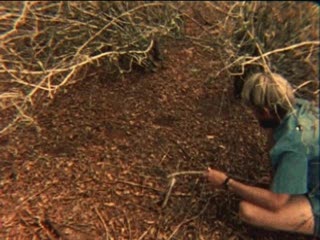 |
Trail in leaf litter
Rufous Sengi
Elephantulus rufescens
Bushwhackers, Kibwezi, Kenya, 1974.
While moving around their home ranges, most species of Elephantulus use the same routes. If the substrate is covered with leaf-letter or grass, these routes become visible trails. Because sengis rely on rapid cursorial locomotion to escape predators, it is vital that their trails are well maintained.
|
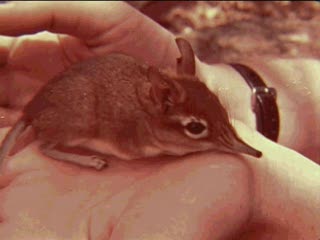 |
In-hand
Elephantulus
Rufous Sengi
Elephantulus rufescens
Bushwhackers, Kibwezi, Kenya, 1974.
Like all sengi, Elephantulus has a highly mobile snout, large eyes and ears, and a small mouth with a long extensile tongue.
|
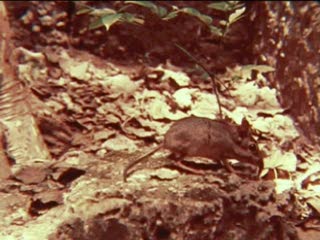 |
Petrodromus
Petrodromus tetradactylus
Gedi Ruins, Watamu, Kenya, ca. 1971.
There is only one species in the genus Petrodromus, which is widespread in central and eastern Africa and is similar to Elephantulus in terms of behavioral ecology, although it is much larger and occupies dense woodlands, thickets, and forests.
|
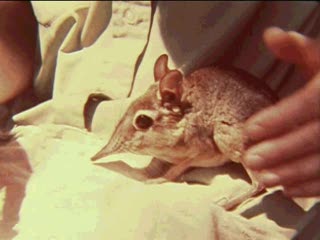 |
In-hand
Petrodromus
Four-toed Sengi
Petrodromus tetradactylus
Gedi Ruins, Watamu, Kenya, ca. 1971.
The very large eyes and ears, small mouth, and long extensile tongue are similar to all other sengis.
|
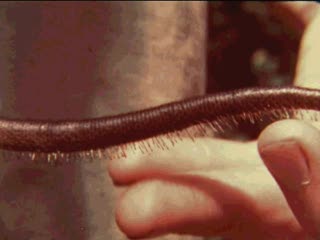 |
Petrodromus bristles
Four-toed Sengi
Petrodromus tetradactylus
Gedi Ruins, Watamu, Kenya, ca. 1971.
The bristles on the bottom of the tail have been attributed to sensing vibrations
through the ground. However, each hair is associated with a gland, which suggests
that the hairs are used to deposit scent on the ground. A rock engraving from
Northern Cape Province of South Africa, showing several small mammals with sengi-like
heads (view
image of engraving), were initially thought to be fantasy composite animals, but because they
clearly have tail bristles, most surely these images represent Petrodromus (view
image of tracing). These are the only known rock images of
sengis,
but oddly there are no Petrodromus currently within hundreds of kilometers
of the engravings.
|











